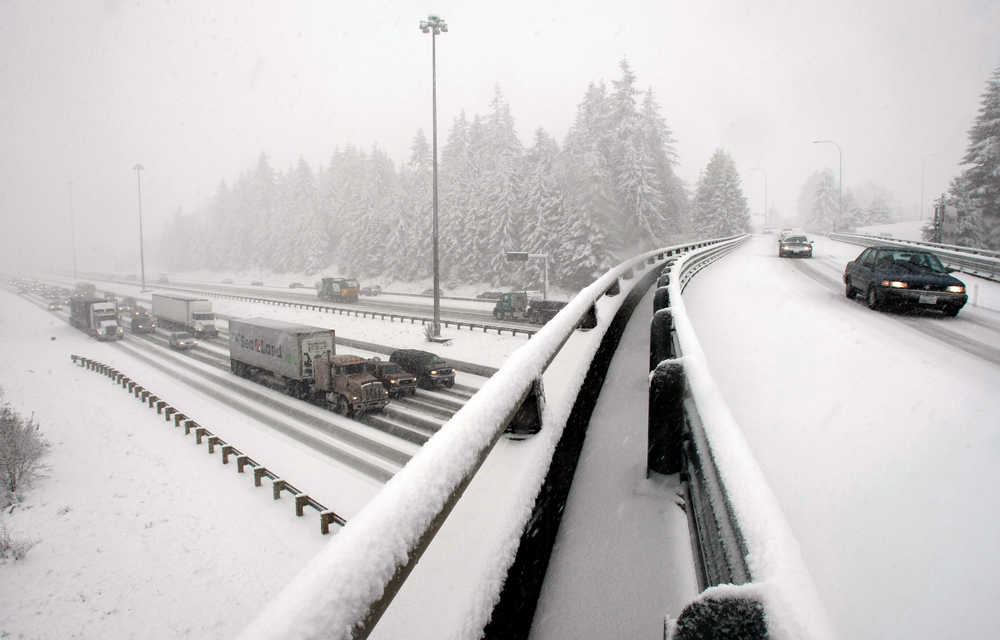SPOKANE, Wash. — Researchers at Washington State University are working on environmentally friendly ways that use less salt to reduce snow and ice on roads.
Their work comes amid growing concerns about the impact of salt and chemical deicers on the environment, said Xianming Shi, WSU associate professor in civil and environmental engineering.
“We are kind of salt addicted … as it’s been so cheap and convenient for the last 50 years,” said Shi, who is assistant director of the new Center for Environmentally Sustainable Transportation in Cold Climates.
It studies cold climate road ecology, a field of study which includes green snow and ice control. Funded by the U.S. Department of Transportation, the center is a collaborative effort between WSU, the University of Alaska-Fairbanks and Montana State University.
Roadways made slippery by snow and ice are a big problem in the northern United States. According to The Salt Institute in Alexandria, Virginia, about 17 million tons of deicing salt is applied to roadways in the U.S. each year.
Every winter, more than 116,000 Americans are injured and some 1,300 are killed as a result of pavement that is covered in snow, slush or ice, according to the institute. Road salt reduces crashes by 88 to 93 percent, the institute said.
Morton Satin of The Salt Institute said salt will continue to be spread on roads for a long time.
The institute has worked for years on developing methods to reduce the amount of road salt that gets into the environment, Satin said.
The science of clearing snow and ice off roads is very complex, said Ron Wright, who works for the Idaho Transportation Department
Issues include the temperature at which various products will work, the damage various chemicals cause to vehicles and roadways and the impacts on the environment. Deicing chemicals also need to have a long shelf life so they can be stockpiled, he said.
“The sodium chloride rock salt has been a long established, well-utilized, functional tool,” said Wright, a member of the Pacific Northwest Snowfighters, an association of state transportation agencies dedicated to ensuring the safety of winter roads by evaluating different products.
It includes the states of Idaho, Washington, Oregon, Montana and Colorado.
The U.S. spends $2.3 billion each year to remove highway snow and ice, plus another $5 billion to mitigate the hidden costs associated with the process, Shi said. Hidden costs include long-term impacts of salt, sand and chemical deicers on the environment, roads and vehicles.
In Washington state, for example, road crews apply roughly four tons of salt per lane mile per winter season, Shi said.
“With a four-lane highway, you have 16 tons of salt per year in that one mile segment,” he said. “In 50 years, that’s about 800 tons of salt in that one mile – and 99 percent of it stays in the environment. It doesn’t degrade.”
Shi’s research has led to advances like the smart snowplow, which comes loaded with sensors and is already being integrated into winter fleets.
“Ordinary snowplows have at least one sensor to measure pavement temperature,” he said. “Smart snowplows not only read temperature, but also residual salt from previous applications, the presence of ice and the amount of friction on the road. All of these readings help operators apply less salt.”
At Washington State, Shi’s passion is cooking up green deicers.
“There is a lot of talk about beet and tomato juice deicers that are meant to be less corrosive to vehicles, guard rails, steel bridges and concrete pavement,” Shi said. “They help, but there is still plenty of room for improvement.”
Shi has developed an ice-melt composed of leftover barley residue from vodka distilleries.
However, most of the green products on the market are blended with chlorides before they are used, Shi said.
He is also testing new types of concrete. Deicer-resistant concrete, for instance, doesn’t break down as quickly in the presence of salt and chemicals, he said. For ice-free concrete, Shi adds tiny particles that prevent the pavement from bonding with ice.
“Our ultimate goal is to apply the best amount of salt, sand or deicers at the right location at the right time,” Shi said.


